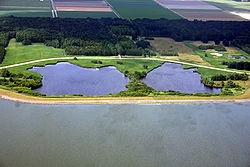
Inundation of the Wieringermeer
Encyclopedia

Polder
A polder is a low-lying tract of land enclosed by embankments known as dikes, that forms an artificial hydrological entity, meaning it has no connection with outside water other than through manually-operated devices...
Wieringermeer
Wieringermeer
Wieringermeer is a municipality and a polder in the Netherlands, in the province of North Holland.- Population centres :The municipality of Wieringermeer consists of the following cities, towns, villages and/or districts: Kreileroord, Middenmeer, Slootdorp, Wieringerwerf.- History :Around the year...
, the Netherlands
Netherlands
The Netherlands is a constituent country of the Kingdom of the Netherlands, located mainly in North-West Europe and with several islands in the Caribbean. Mainland Netherlands borders the North Sea to the north and west, Belgium to the south, and Germany to the east, and shares maritime borders...
.
Preparations
In the end of February or the beginning of March 1945 Dutch workers started to undermine the dike around the polder under German command. The location is near the farm of Beetstra, in the dike with the IJsselmeerIJsselmeer
IJsselmeer is a shallow artificial lake of 1100 km² in the central Netherlands bordering the provinces of Flevoland, North Holland and Friesland, with an average depth of 5 to 6 m. The IJsselmeer is the largest lake in Western Europe....
.
Deep holes were dug in the dike both at the bottom and at the top of the dike. In these holes explosives would be put. The work was progressing slowly since none of the workers were motivated. In April the work came to a complete stop.
On April 10 German officers came and inspected the work. New workers were sought and 25 to 50 people were taken from Schagen
Schagen
Schagen is a town and municipality in the northwestern Netherlands. It is located between Alkmaar and Den Helder, in and region of West Friesland and the province of North Holland. In 2007, Schagen had 19.078 residents. It received city rights in 1415....
during a razzia to work on the digging. After a week the holes were deep enough and explosives were installed. Each hole was loaded with 1000 kg. of explosives; unexploded bombs from British and American aircraft were used.
On 17 April at 12.15 am the explosives were ignited. The 7,000 people in the Wieringermeer and the estimated 1000 to 2000 refugees had to leave the polder. Within 48 hours the entire polder was full with water, with an average depth of 3.75 m.

